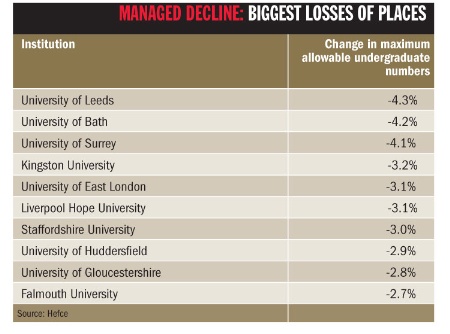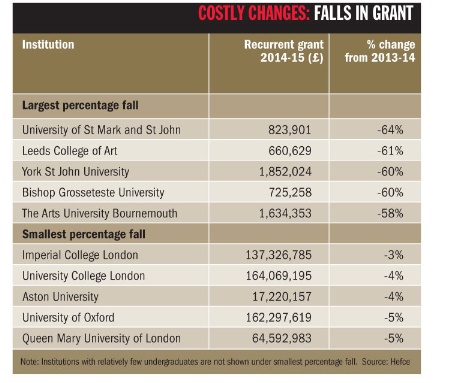Universities that proved less popular with undergraduates this year have had their student number allocations for next year cut, despite the government making 30,000 extra places available.
Figures from the Higher Education Funding Council for England reveal for the first time which universities did not meet their places quotas in 2013-14, a year in which most institutions’ enrolments bounced back after the first year of higher tuition fees.
Big post-1992 universities such as Kingston University, the University of East London, Liverpool Hope University and Staffordshire University will all have undergraduate allocations cut by about 3 per cent for next year, indicating that they fell short by corresponding amounts this year.
But institutions facing a cut – which may have intended not to fill their allocations last year – will be given the chance to recover next year via more “flexibility” on student numbers. Hefce revealed the figures in its announcement of recurrent grants and student number controls for 2014-15, published on March. This provisionally allocates £3.9 billion of funding: £1.6 billion for teaching, £1.6 billion for research, £160 million for knowledge exchange and £583 million for “national facilities” and capital funding.
Earlier this month, Hefce warned institutions that most teaching budgets will drop by 5.85 per cent in 2014-15. This fall was greater than expected, largely reflecting that funding must stretch to cover the extra 30,000 places.
George Osborne, the chancellor, announced in December’s Autumn Statement that there would be 30,000 extra student places in 2014-15, as a prelude to abolishing the cap on student numbers entirely in 2015-16.

Hefce had already said that it would allocate places for next year based on this year’s student demand, but that was before the government announced the 30,000 extra places and the removal of the numbers cap.
Hefce says in its report on the allocations that it “distributed the overall 30,000 increase in places available in a way which…gives providers significant scope to grow if they have the demand from students”.
Student number allocations were raised “for those that recruited strongly” and cut “for those that significantly under-recruited”. The level of reductions reflected “the extent to which [institutions’] recruitment came below the bottom of the 2013-14 flexibility range”, Hefce adds.
Now with more flexibility
The flexibility threshold – which allows an institution to exceed its student number control without being punished for over-recruitment – has also been raised, from 3 per cent to 6 per cent of an institution’s 2014-15 number control, using up most of the extra 30,000 places.
Hefce says that it will still fine institutions that exceed the flexibility threshold on their student number controls by reducing their grant.
Institutions may recruit unlimited numbers of students with ABB grades and above at A level or the equivalent. Only recruitment of non-ABB students is subject to number controls.
Times Higher Education was not able to ask institutions why they fell short on undergraduate quotas because the figures were issued under a “no approach” embargo.
It may be that some that failed to meet this year’s number controls and had allocations cut – such as Leeds, Bath and Surrey – chose not to recruit large numbers of non-ABB students and instead focused on ABB students.
Post-1992 universities could suffer more from under-recruitment because they are likely to find it harder to recruit ABB students. But they, too, may have deliberately under-recruited as part of a policy to raise entry standards.
Some of the most selective universities have been allocated more non-ABB places (the University of Bristol’s increased by 72.8 per cent to 385), potentially allowing them to make more offers to disadvantaged students without the top grades.

Hefce’s release also reveals which institutions are most and least affected in the third year that teaching grant has been withdrawn and replaced by £9,000 tuition fees.
Small teaching institutions with few high-cost subjects (which still retain some grant support) have had their Hefce grant cut by up to 64 per cent compared with 2013-14’s grant announcement, as they lose another tranche of “old regime” students who came with direct grant.
Meanwhile an institution such as Imperial College London, which teaches high-cost subjects and earns large sums of research funding, sees its grant shrink by just 3 per cent (see tables, above).
Register to continue
Why register?
- Registration is free and only takes a moment
- Once registered, you can read 3 articles a month
- Sign up for our newsletter
Subscribe
Or subscribe for unlimited access to:
- Unlimited access to news, views, insights & reviews
- Digital editions
- Digital access to THE’s university and college rankings analysis
Already registered or a current subscriber?





